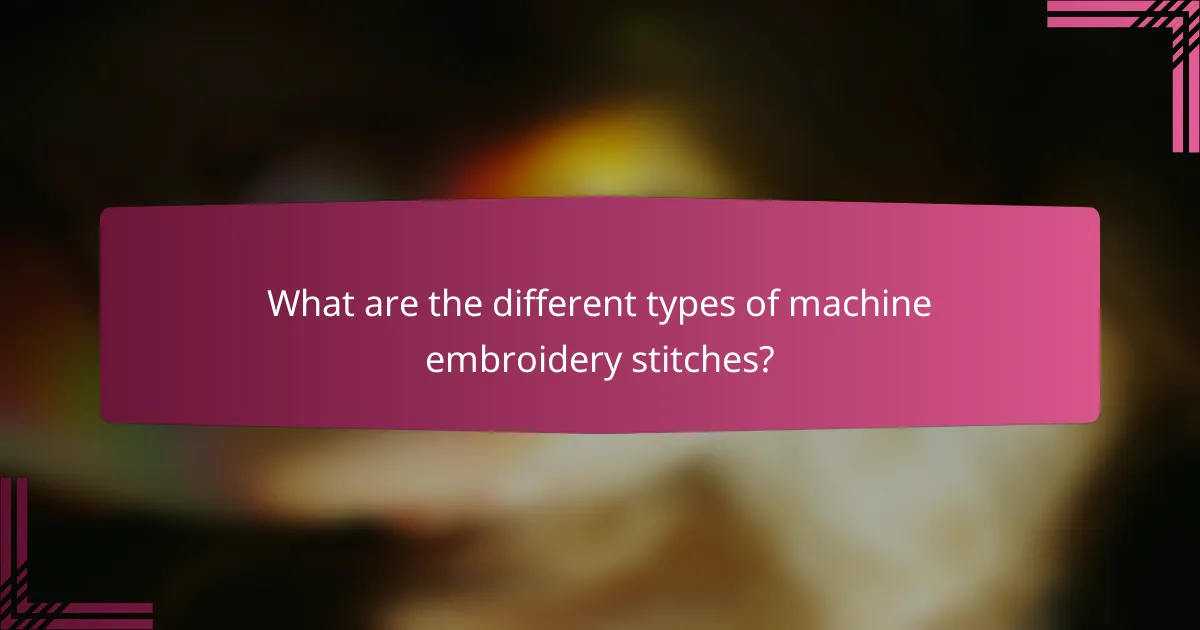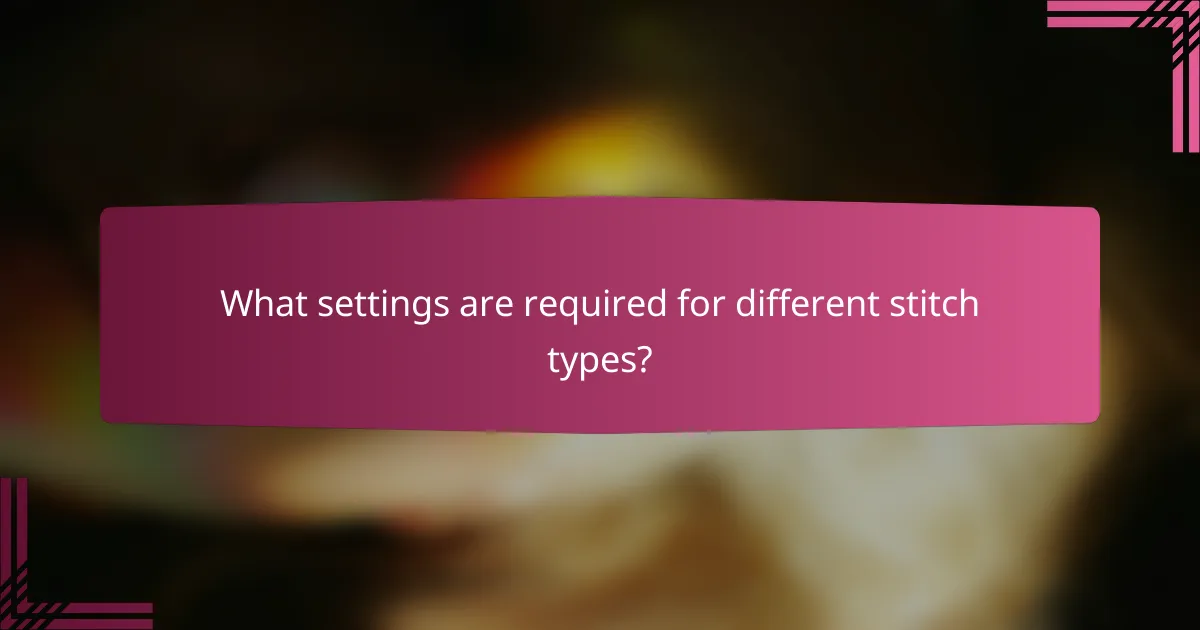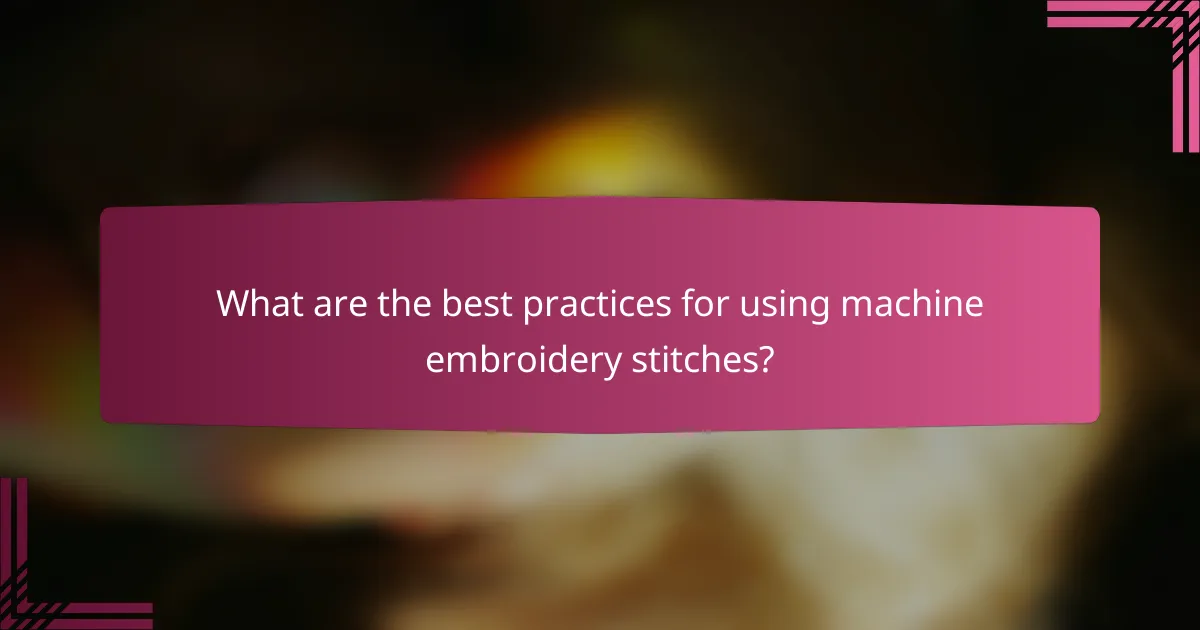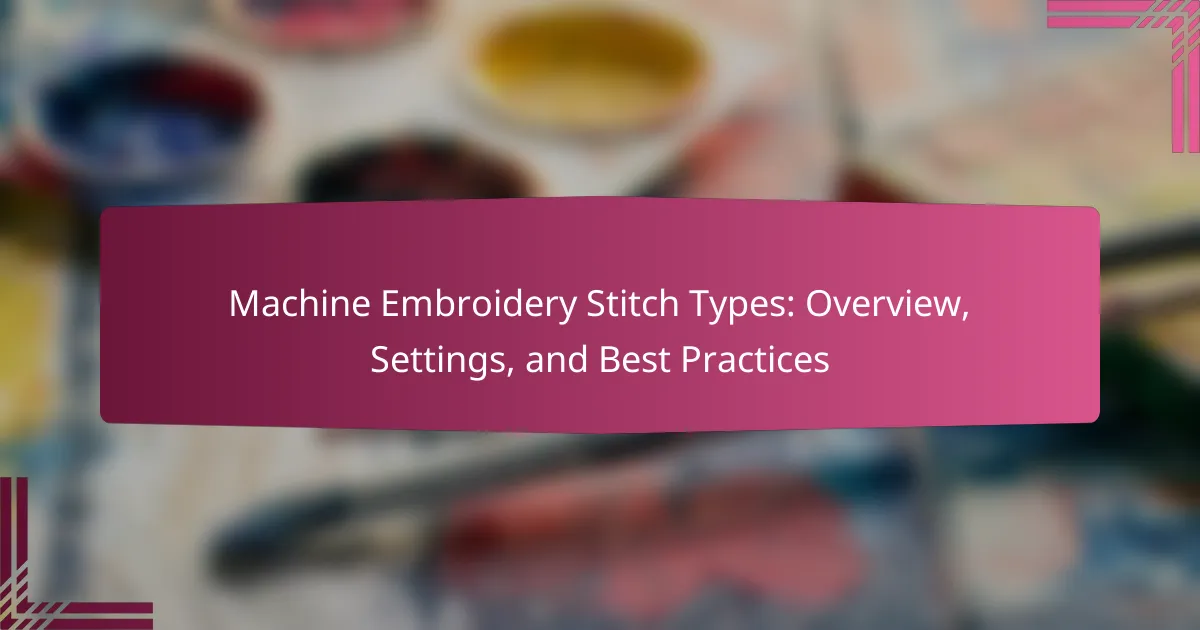
What are the different types of machine embroidery stitches?
The different types of machine embroidery stitches include straight stitches, zigzag stitches, satin stitches, and fill stitches. Straight stitches are used for outlining and basic designs. Zigzag stitches allow for stretch and are often used in appliqué. Satin stitches create smooth, shiny areas and are ideal for lettering. Fill stitches cover larger areas with designs and patterns. Each stitch type serves a unique purpose in machine embroidery, enhancing the overall design and functionality.
How do these stitch types vary in application?
Stitch types vary in application based on their intended use and the fabric being stitched. For instance, satin stitches are commonly used for filling shapes and creating smooth surfaces. They are ideal for designs requiring a glossy finish. Conversely, zigzag stitches provide stretch and are suitable for knit fabrics. They allow for flexibility without breaking the thread.
Running stitches are often employed for outlining and detailing, as they create clean, precise lines. Additionally, fill stitches cover larger areas and are used for solid designs. Their density can be adjusted based on the fabric weight.
Lastly, specialty stitches, like the French knot, are used for decorative purposes, adding texture and dimension. Each stitch type serves a unique function, enhancing the overall design and durability of the embroidery.
What are the characteristics of basic stitch types?
Basic stitch types in machine embroidery include straight, zigzag, and satin stitches. Each type has distinct characteristics. Straight stitches are linear and provide a clean finish. Zigzag stitches feature a back-and-forth motion, allowing for flexibility and stretch. Satin stitches consist of closely spaced parallel lines, creating a smooth, shiny surface.
Straight stitches are often used for outlining and basic seams. Zigzag stitches are ideal for appliqué and decorative edges. Satin stitches are commonly utilized for filling shapes and adding texture. These variations serve different purposes in embroidery, enhancing both functionality and aesthetics.
How are decorative stitches different from utility stitches?
Decorative stitches are primarily used for embellishment, while utility stitches serve functional purposes. Decorative stitches enhance the aesthetic appeal of fabric through intricate designs. Utility stitches, on the other hand, focus on construction and durability, such as straight and zigzag stitches. Decorative stitches often feature complex patterns and varied thread colors. Utility stitches are generally simpler and more straightforward in their design. The distinction lies in their intended use; decorative stitches add beauty, while utility stitches provide strength and practicality.
Why is understanding stitch types important for embroidery projects?
Understanding stitch types is crucial for successful embroidery projects. Different stitch types affect the texture, appearance, and durability of the final design. For instance, satin stitches create smooth, shiny surfaces, while fill stitches provide a solid coverage. Choosing the right stitch type can enhance the design’s visual impact. It also influences the fabric’s behavior during and after stitching. Knowledge of stitch types helps in selecting appropriate thread and needle sizes. This understanding prevents issues like thread breakage and fabric puckering. Ultimately, mastering stitch types leads to higher quality embroidery outcomes.
How does stitch selection impact the final outcome?
Stitch selection significantly influences the final outcome of machine embroidery. Different stitches affect the texture, density, and overall appearance of the design. For instance, satin stitches provide a smooth finish, while fill stitches create a more textured look. The choice of stitch also impacts the fabric’s behavior during embroidery. Certain stitches may pull or distort delicate materials, while others may be better suited for heavier fabrics. Additionally, stitch selection affects the durability of the embroidery. High-density stitches can lead to increased wear and tear, while lower-density stitches may enhance flexibility. Overall, careful stitch selection is crucial for achieving the desired aesthetic and longevity in machine embroidery projects.
What role do stitch types play in fabric compatibility?
Stitch types significantly influence fabric compatibility in machine embroidery. Different fabrics require specific stitch types for optimal results. For instance, lightweight fabrics benefit from finer, closer stitch types to prevent puckering. Conversely, heavier fabrics can accommodate more robust stitch types without damaging the material.
The choice of stitch type affects the overall appearance and durability of the embroidery. For example, satin stitches work well on stable fabrics, while zigzag stitches can provide flexibility on stretch fabrics. Additionally, the tension settings may need adjustment based on the stitch type and fabric combination.
Research indicates that using the appropriate stitch type can enhance the longevity of the embroidery and maintain fabric integrity. Thus, understanding the relationship between stitch types and fabric compatibility is crucial for successful machine embroidery projects.

What settings are required for different stitch types?
Different stitch types require specific settings for optimal results. For straight stitches, use a medium stitch length of 2.5 to 3 mm. Zigzag stitches need a width setting of 3 to 5 mm and a length of 2 mm. Satin stitches require a shorter length of 0.5 to 1 mm for dense coverage. For decorative stitches, adjust the width and length based on the design, often between 2 to 6 mm. Each machine may have unique settings, so refer to the manual for precise adjustments. These settings ensure quality and prevent issues like puckering or thread breakage.
How do machine settings affect stitch quality?
Machine settings significantly influence stitch quality in embroidery. Adjustments to tension, speed, and needle type can alter the final appearance of stitches. For instance, improper tension can lead to thread breakage or looping. High-speed settings may cause skipped stitches if the machine cannot keep up. The choice of needle size also affects how the fabric interacts with the thread. Using the correct needle for the fabric type ensures smoother stitching. Additionally, stitch length settings can impact the density and overall look of the design. Properly calibrated machine settings are essential for achieving high-quality embroidery results.
What are the recommended tension settings for various stitches?
The recommended tension settings for various stitches typically range from 2 to 6. Straight stitches usually require a tension setting of 4. Zigzag stitches often perform best at a tension of 3 to 5. For decorative stitches, a setting of 3 to 6 is common. Lower tension settings are suitable for lightweight fabrics. Higher tension may be necessary for thicker materials. These settings help achieve balanced stitches without puckering. Adjustments may be needed based on fabric type and thread thickness.
How does needle type influence stitch performance?
Needle type significantly influences stitch performance in machine embroidery. Different needle types are designed for specific fabrics and thread types. For instance, a ballpoint needle works well with knits, while a sharp needle is ideal for woven fabrics. The needle’s size also affects stitch quality; larger needles create larger holes, which can lead to skipped stitches. Conversely, smaller needles may break when used with thicker threads. Additionally, the needle’s point shape impacts how the fabric is penetrated, affecting the overall stitch appearance. Proper needle selection enhances stitch consistency and reduces fabric damage. This is supported by the fact that using the correct needle type can improve stitch density and reduce thread breakage, leading to better embroidery results.
What adjustments can be made for optimal stitch results?
Adjustments for optimal stitch results include selecting the correct needle type and size. A universal needle works well for most fabrics, while a ballpoint needle is better for knits. Thread tension should be adjusted according to the thread type and fabric thickness. Lower tension is often needed for thicker threads. The stitch length can also be modified; shorter lengths provide more detail, while longer lengths suit bolder designs. Additionally, using stabilizers can prevent fabric distortion during stitching. Proper hooping is crucial as well; it ensures the fabric remains taut. These adjustments help achieve clean and precise embroidery results.
How do speed settings affect the stitching process?
Speed settings directly influence the stitching process in machine embroidery. Higher speed settings allow for faster completion of designs but can lead to issues such as skipped stitches or uneven tension. Lower speed settings provide greater control, resulting in more precise stitching and better quality. For example, intricate designs often require slower speeds to ensure accuracy. Studies show that maintaining optimal speed settings can significantly enhance stitch quality and reduce errors. Therefore, adjusting speed settings is crucial for achieving desired embroidery outcomes.
What are the best practices for thread selection based on stitch type?
The best practices for thread selection based on stitch type involve matching the thread type to the stitch’s purpose and fabric. For straight stitches, use polyester or cotton thread for durability. For decorative stitches, metallic or specialty threads enhance visual appeal. When using heavier stitches like satin, opt for thicker threads to maintain stitch integrity. For lightweight fabrics, fine threads prevent puckering. Additionally, the thread’s sheen should align with the desired finish; matte threads suit casual looks, while shiny threads work for formal designs. Following these guidelines ensures optimal stitch quality and fabric compatibility.

What are the best practices for using machine embroidery stitches?
The best practices for using machine embroidery stitches include selecting the appropriate stitch type for the fabric. Different fabrics require specific stitches to achieve the best results. For example, dense stitches are better suited for stable fabrics, while lighter stitches work well on delicate materials.
Proper tension settings are crucial for optimal stitch quality. Adjusting the top and bobbin tension ensures even stitching and prevents puckering. Regular maintenance of the embroidery machine also enhances stitch performance. Cleaning the machine and replacing needles as needed can prevent thread breaks and improve stitch consistency.
Using high-quality threads is essential for achieving professional results. Quality threads reduce fraying and breakage, leading to smoother stitching. Additionally, stabilizers should be utilized to support the fabric during embroidery. Choosing the right stabilizer based on fabric weight and stitch density can prevent distortion.
Lastly, testing stitches on a fabric scrap before starting the actual project is a recommended practice. This allows for adjustments in tension, stitch type, and stabilizer choice to be made, ensuring the best outcome for the final piece.
How can you troubleshoot common stitching issues?
To troubleshoot common stitching issues, first identify the type of problem occurring. Issues may include thread breakage, uneven stitches, or skipped stitches. For thread breakage, check the thread tension and ensure the thread is properly threaded through the machine. Uneven stitches can be resolved by adjusting the stitch length and ensuring the fabric is correctly stabilized. Skipped stitches often occur due to a dull needle or incorrect needle type; replace the needle with the appropriate size and type for the fabric. Regular maintenance of the machine, such as cleaning and oiling, can prevent many stitching issues.
What steps should be taken if stitches are skipping?
If stitches are skipping, first check the needle type and size. Ensure the needle is appropriate for the fabric being used. Replace the needle if it is dull or damaged. Next, examine the thread tension settings. Adjust the tension according to the thread type and fabric weight. Ensure the thread is correctly threaded through the machine. Rethread the machine if necessary to eliminate any threading issues. Check the bobbin for proper placement and ensure it is wound evenly. Replace the bobbin if it is damaged or improperly wound. Lastly, clean the machine to remove any lint or debris that could affect performance. Regular maintenance can prevent skipping stitches in the future.
How do you fix thread breakage during embroidery?
To fix thread breakage during embroidery, first check the thread tension. Incorrect tension can cause the thread to break. Adjust the tension settings according to the thread type used. Next, ensure the needle is appropriate for the fabric and thread. A damaged or incorrect needle can lead to breakage. Replace the needle if it shows signs of wear.
Additionally, use high-quality thread designed for embroidery. Poor-quality threads are more likely to break. Clean the machine regularly to remove lint and debris. This maintenance prevents interference with the thread path. Lastly, slow down the embroidery speed if breakage persists. Slower speeds can reduce strain on the thread and machine.
What tips can enhance the overall embroidery experience?
To enhance the overall embroidery experience, use high-quality materials. Select threads that are durable and colorfast. Choose stabilizers that suit your fabric type for better results. Maintain your embroidery machine regularly to prevent malfunctions. Adjust tension settings based on the thread and fabric used. Test designs on scrap fabric to avoid mistakes on the final piece. Keep your workspace organized to streamline the process. Lastly, stay updated on techniques and trends through workshops or online resources.
How can proper hooping techniques improve stitch accuracy?
Proper hooping techniques enhance stitch accuracy by ensuring the fabric remains taut and stable during the embroidery process. When fabric is properly hooped, it minimizes movement and distortion. This stability allows the needle to penetrate the fabric consistently. Consistent [censured] leads to even stitch formation. Additionally, proper hooping prevents puckering and misalignment. Research indicates that misaligned fabric can result in a 20% increase in stitch errors. Therefore, correct hooping is crucial for achieving high-quality embroidery results.
What maintenance practices help ensure consistent stitch quality?
Regular maintenance practices include cleaning, lubrication, and timely inspections. Cleaning the machine removes lint and debris that can affect stitch quality. Lubrication ensures smooth operation of moving parts, reducing friction. Inspecting the needle and thread tension helps maintain consistent stitch formation. Replacing worn needles prevents skipped stitches and thread breakage. Checking the bobbin case and feed dogs ensures proper fabric feeding. Keeping the machine calibrated maintains accurate stitch placement. Following these practices leads to improved stitch quality and machine longevity.
Machine embroidery stitch types encompass various techniques such as straight, zigzag, satin, and fill stitches, each serving specific functions in design and application. The article provides an overview of these stitch types, detailing their characteristics, applications, and the importance of selecting the appropriate stitch for different fabrics. Additionally, it discusses essential machine settings, tension adjustments, and best practices for achieving optimal stitch quality and durability. Troubleshooting common issues like thread breakage and skipped stitches is also addressed, ensuring a comprehensive guide for successful machine embroidery projects.
